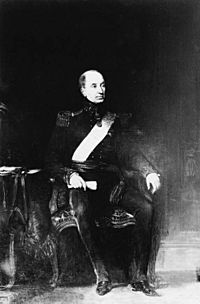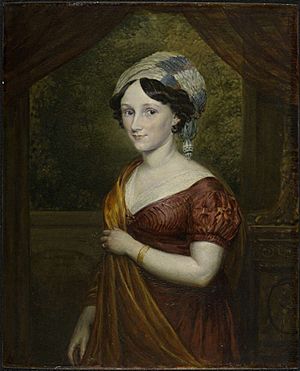Ralph Darling facts for kids
Quick facts for kids
Ralph Darling
GCH
|
|
|---|---|
 |
|
| 7th Governor of New South Wales | |
| In office 19 December 1825 – 21 October 1831 |
|
| Monarch | George IV William IV |
| Preceded by | Thomas Brisbane |
| Succeeded by | Richard Bourke |
| Personal details | |
| Born | 1772 Ireland |
| Died | 2 April 1858 (aged 85-86) Brighton, England |
| Military service | |
| Allegiance | United Kingdom |
| Branch/service | British Army |
| Rank | General |
| Commands | British troops on Mauritius 51st (2nd Yorkshire West Riding) Regiment of Foot |
| Battles/wars | Napoleonic Wars |
| Awards | Knight Bachelor Knight Grand Cross of the Royal Guelphic Order |
Sir Ralph Darling (born 1772, died 1858) was a British Army officer. He became the Governor of New South Wales, a colony in Australia, from 1825 to 1831. Some people thought he was a strict leader. Many places in Australia are named after him, like the Darling River and Darling Harbour in Sydney.
Contents
Becoming a General
Ralph Darling had a very unusual career in the British Army. He started as an ordinary soldier, called an enlisted man. Then, he worked his way up to become a general officer and even received a special honor called a knighthood.
He was born in Ireland. His father was a sergeant in the army. Later, his father was promoted to an officer, which was rare.
Ralph Darling joined his father's regiment when he was just 14 years old. He served as a private soldier for at least two years. He was stationed in the West Indies.
In 1793, when he was 21, Ralph became an officer, an ensign. He did not have to pay for this position, which was also very unusual. He quickly showed he was very good at his job.
He worked in both fighting roles and important office jobs. In 1796, he became a military secretary to Sir Ralph Abercromby. Sir Ralph was the British commander in the West Indies. By 1802, at only 29, Darling was a respected lieutenant-colonel.
Serving in Wars
During the Napoleonic Wars, Colonel Darling led soldiers and held important administrative roles. He led the 51st Regiment of Foot in the Battle of Corunna. He also served as an assistant adjutant general during the Walcheren Expedition.
After these duties, he returned to London. For almost ten years, he was in charge of recruiting soldiers for the British Army. During this time, he was promoted several times. He became a major general in 1813.
General Darling also helped his younger brothers, Henry and William, and his nephew Charles, to advance their careers. All three brothers became generals, and Charles also received a knighthood.
Time in Mauritius
In 1817, Darling got married. From 1819 to 1824, General Darling commanded British troops on the island of Mauritius. For the last three years there, he also served as the acting governor.
He showed strong leadership skills in Mauritius. However, he also became quite unpopular with some people. He was accused of allowing a ship to break quarantine rules. This was thought to have caused a disease outbreak.
But there was no real proof the ship carried the disease. Many people who opposed him were unhappy because he was trying to stop the slave trade. Mauritius was also a former French colony, and some people did not like British rule.
Even with some criticism, his work in Mauritius was important. It helped him get appointed as the seventh Governor of New South Wales in 1824.
Governor of New South Wales
As Governor, Ralph Darling started many important projects.
Building Roads and Defining Land
In 1826, he began building the Great North Road. Convicts built this road. It connected settlements around Sydney with those in the Hunter Valley.
In the same year, he set up the Nineteen Counties. These were specific areas where settlers were allowed to live and own land. This was done based on orders from the British government. From 1831, the government stopped giving away free land. All land for sale had to be within these Nineteen Counties.
Expanding the Colony
When Darling became governor, the western border of the colony was extended. It moved 6 degrees further west. This new line later became the border between Western Australia and South Australia.
To the south, the area beyond Wilsons Promontory was no longer part of New South Wales. It was placed under the control of the Lieutenant Governor of Van Diemen's Land. On December 3, 1825, Darling officially declared Van Diemen's Land (now Tasmania) as a separate colony.
Later Life
Ralph Darling left Australia in 1831 and returned to England in 1832. Some of his political opponents continued to criticize his actions in Australia. A special committee was formed to look into his time as governor.
However, the committee found him innocent of any wrongdoing. The very next day, the king honored him with a knighthood. This showed strong support from the government.
Even though he was cleared, he did not get any major new military or political jobs. But he did receive more promotions and honorary titles. He spent much of his time raising his young children.
He continued to hold important positions in different army regiments until his death.
Ralph Darling passed away in Brighton, England, on April 2, 1858. He was 86 years old. He was survived by his wife, three sons, and four daughters.
Family Life
On October 13, 1817, Darling married Elizabeth Dumaresq, who was 19 years old. She was known as Eliza (1798–1868). Her father was a landowner in Shropshire. They had a very happy marriage. Out of ten children, four daughters and three sons lived to be adults.
Eliza's mother, Ann Dumaresq, was a kind person who helped others. Eliza was inspired by other reformers of her time. In Australia, she talked with Elizabeth Fry, who worked to improve prisons. Eliza was especially interested in helping female convicts. She also helped start the Female School of Industry in Parramatta.
After Ralph Darling's time as governor ended, the family moved back to England. They lived in Cheltenham and then Brighton, where Darling died in 1858.
Places Named After Ralph Darling
Many places are named after Ralph Darling or his family members. This shows his lasting impact on Australia.
- Darling River
- Darling Harbour
- Darling Downs
- Darling Scarp, also called the Darling Range or Darling Ranges
- Darling Causeway, a landform in the Blue Mountains
- Darling Street, a main road in Balmain
- The Sydney suburbs of Darlinghurst and Darling Point
The Logan River in South-East Queensland was first named the Darling River in 1826. This was done by Captain Patrick Logan to honor Governor Darling. However, Darling decided to rename it the Logan River. He did this to recognize Captain Logan's hard work and efficiency.
Images for kids
See also
 In Spanish: Ralph Darling para niños
In Spanish: Ralph Darling para niños




